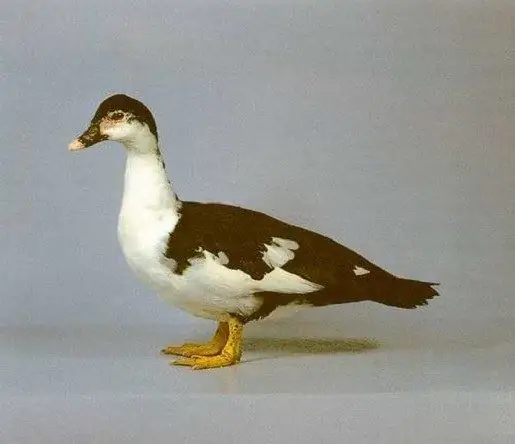- Author Delia Mathews [email protected].
- Public 2023-12-16 00:05.
- Last modified 2025-01-22 15:45.
The Barbary duck is the name of the musky duck or Cairina moschata, which came from the French poultry industry. This type of bird is considered to be quite large. For the first time it was domesticated in its original place of distribution - in Mexico and South America, from where then the Barbarian ducks were brought to the countries of the Old World.

What does a barbarian or musk duck look like?
The plumage of females living in the wild is usually dark in color, diluted with a few "blotches" of white feathers. Currently domesticated birds, which have undergone some crossing with ducks of other breeds, can be quite varied in colors such as black, white, black white-winged, fawn, and many others.
Characteristic of Barbarian ducks are also peculiar fleshy growths, located half a centimeter above the beak, between the eyes of birds of both sexes. These formations are red in color and are called "corals" or "duck warts" by poultry farmers.
Drakes are usually somewhat larger than females (1, 3-1, 5 kilograms and 60-65 centimeters), and reach a weight of 3 kilograms, as well as lengths up to 90 centimeters. These measurements are more typical for wild individuals. At home, barbarian ducks are usually slightly larger. For example, males can weigh 4-6 kilograms, and females up to 3 kilograms.
Barbarian ducks feed on the common food for most birds - plant and animal food. It can be grass, as well as small insects.
The period of incubation of eggs is the same for both wild and domesticated ducks - only 34-36 days. But a bird living next to a person produces on average 8-14 eggs per clutch, and a wild one - 8-10 eggs.
What does barbarian duck taste like?
Home-bred duck has one feature - it grows much slower than the usual Peking duck, so only true connoisseurs grow barbarian birds.
It is believed that this type of bird has a rather lean meat, which tastes more pleasant than that of the Peking "competitors", mallards and other types of domestic ducks.
The Barbary duck is very thermophilic, not loud and silent, and domesticated individuals avoid swimming in open water bodies.
Breeders, striving to find a "golden mean" between the Peking and Barbary ducks, also bred a new breed of bird - the mullard, the weight of which can reach 4-4.5 kilograms. According to French culinary experts, it is the mullard's liver that is the ideal raw material for the preparation of liver delicacies and foie gras.
But this is not the end of the useful "properties" of barbarian ducks. French pharmacists have learned to isolate from its meat the constituent of such a homeopathic preparation - oscillococcinum, which is used in the fight against colds.






